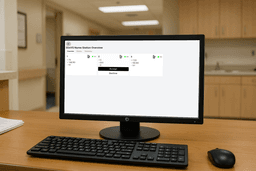In nursing education, simulation is no longer just about checking off skills. It's about preparing students for the complex, high-pressure environments they'll face the moment they enter practice. One of the most overlooked aspects of that preparation? The role of the charge nurse.
That's where SimVS Nurse Station comes in.
SimVS Nurse Station is the first simulation solution purpose-built to help students transition from task-based learning to unit-based leadership. But how exactly is it used in real nursing programs?
Let's explore a few real-world use cases:
Watch how SimVS Nurse Station transforms nursing education by providing realistic charge nurse simulation experiences:
Setting
Junior-level med-surg course
Objective
Escalate care for deteriorating patient and coordinate team response
Scenario Overview
A student acting as charge nurse monitors a unit with six beds. One bedside student identifies early signs of sepsis. Through the Nurse Call system, they activate a help request.
The charge nurse must:
- Interpret the urgency
- Escalate to the simulated provider using SBAR
- Coordinate an immediate response from another nurse on the unit
Assessment Focus: Instructors assess prioritization, communication accuracy, and how well students collaborate under pressure.
Setting
Capstone leadership rotation
Objective
Lead interdisciplinary rounding and delegate follow-up tasks
Scenario Overview
Using a built-in Nurse Station scenario, students lead simulated morning rounds. They receive prompts from physicians, respiratory therapists, and pharmacy via tablet messages.
The student must:
- Lead updates on each patient
- Prioritize outstanding needs
- Delegate nursing tasks based on scope and acuity
Assessment Focus: This use case allows instructors to observe leadership presence, confidence in communication, and understanding of interprofessional dynamics.
Setting
First-semester fundamentals course
Objective
Practice communication and role clarity under low-stakes conditions
Scenario Overview
Even early learners benefit from exposure to Nurse Station. In this use case, they take turns managing a night shift scenario:
- Addressing low-priority calls (e.g., "I need a blanket")
- Taking handoff reports
- Updating the instructor on room status
Learning Outcome: Though the clinical complexity is low, this experience builds confidence in answering calls, relaying information clearly, and documenting appropriately.
These scenarios show how SimVS Nurse Station supports a whole-part-whole learning model:
Whole
Start with the complete clinical context and scenario
Part
Break down and practice individual communication skills
Whole
Apply refined skills back to complex, unfolding scenarios
With flexible scripting, real-time alerts, and customizable configurations, Nurse Station is more than a product—it's a platform for scalable, curriculum-aligned leadership training.
Related Articles

Introducing SimVS Nurse Station: The Future of Nursing Leadership Training
Discover how SimVS Nurse Station transforms nursing education with innovative simulation technology.
Read Article
Complete Guide to IV Training with Medical Simulation
Master intravenous therapy techniques through hands-on simulation training.
Read Article